Ijraset Journal For Research in Applied Science and Engineering Technology
- Home / Ijraset
- On This Page
- Abstract
- Introduction
- Conclusion
- References
- Copyright
A Deep Learning Approach for Papaya Disease Identification
Authors: Preeti Gupta, Mr. Omprakash Sinha
DOI Link: https://doi.org/10.22214/ijraset.2024.63409
Certificate: View Certificate
Abstract
Papaya disease poses a significant threat to farmers worldwide, leading to substantial losses annually. Recognizing the urgency of mitigating these losses, researchers have increasingly focused on developing papaya disease recognition systems. However, farmers often lack awareness of detection techniques, resulting in disease identification only after the papayas are already affected, leading to wasted crops and financial losses. Consequently, many farmers are hesitant to continue papaya cultivation. To address this issue, we conducted research leveraging deep learning technology for papaya disease detection and classification. Specifically, we employed a convolutional neural network (CNN) model using the Keras API. Our model features a fully connected architecture for robust classification, and the entire process is based on deep learning principles. We utilized 200x200 RGB images as input, standardizing the image size for consistency. This research aims to empower farmers with an effective tool for early disease detection, thereby reducing crop losses and revitalizing confidence in papaya cultivation. The proposed system achieves classification accuracy of around 94%.
Introduction
I. INTODUCTION
Papaya (Carica papaya L.) is a tropical fruit native to Central America and southern Mexico, now cultivated in many tropical regions around the world. It is a rich source of vitamins A, C, and E, as well as papain, a digestive enzyme. Papaya production plays a significant role in the economies of many developing countries, and it is also gaining popularity in developed countries due to its nutritional value and delicious taste. However, papaya cultivation faces numerous challenges, with various diseases significantly impacting yield and fruit quality. Papaya Ringspot Virus (PRSV), Papaya Black Spot (PBS), and fungal diseases like Anthracnose and Phytophthora are some of the most common and destructive diseases affecting papaya crops. These diseases can cause devastating losses, leading to reduced fruit production, poor fruit quality, and even complete crop failure. Early and accurate identification of papaya diseases is crucial for effective disease management strategies. Traditional methods of disease identification rely on visual inspection by farmers. However, this approach has limitations. Firstly, it is subjective and depends on the experience and expertise of the farmer. Inexperienced farmers might struggle to identify diseases in their early stages, leading to delayed intervention and greater yield losses. Secondly, visual inspection is time-consuming, especially for large farms. Finally, some diseases can exhibit subtle symptoms that are difficult to detect with the naked eye. These limitations highlight the need for more objective, automated, and reliable techniques for papaya disease identification. This paper explores the application of deep learning, a subfield of machine learning, for achieving this goal.
II. RELATED WORK
A. Papaya Disease Recognition
Traditional methods of papaya disease identification rely on visual inspection by farmers. This method is subjective and depends on the farmer's experience and knowledge of papaya diseases. An inexperienced farmer might struggle to differentiate between healthy and diseased plants, especially in the early stages of infection when symptoms are mild. Deep learning offers a promising alternative to traditional methods of papaya disease identification. Deep learning algorithms can be trained to automatically identify diseases from images of papaya plants. This approach offers several advantages over visual inspection. Firstly, deep learning models are objective and consistent in their analysis. They can be trained on a large dataset of labeled images, encompassing various papaya diseases and their different stages of progression. This training enables the model to learn the characteristic visual patterns associated with each disease, allowing for accurate identification even in the early stages. Secondly, deep learning models are fast and efficient. They can analyze images rapidly, making them suitable for large-scale disease detection in commercial papaya farms. Finally, deep learning models have the potential to detect subtle visual symptoms that might be missed by the human eye. This can lead to earlier disease detection and more effective disease management strategies.

B. Machine Learning Techniques
Supervised learning algorithms are fundamental in machine learning, particularly for tasks such as papaya disease prediction. In supervised learning, a labeled dataset is essential, comprising data points (papaya images) each linked to a corresponding label (healthy or diseased). Through analysis of these labeled examples, the machine learning model discerns patterns and connections between features extracted from the images and the presence of specific diseases. There are various types of supervised learning algorithms, but some of the most common and effective choices for image classification tasks include:
- Classification Algorithms: These algorithms are designed to learn a mapping function that maps the input image data (features extracted from the papaya images) to a discrete set of output categories (disease types or healthy). Popular classification algorithms for papaya disease prediction include Support Vector Machines (SVMs), Random Forests, and K-Nearest Neighbors (KNN).
- Deep Learning Algorithms: Deep learning is a subfield of machine learning that utilizes artificial neural networks with multiple hidden layers. These complex architectures allow deep learning models to learn intricate patterns and relationships in data, making them highly effective for image classification tasks. Convolutional Neural Networks (CNNs) are a specific type of deep learning architecture that excel at image recognition. As discussed earlier, CNNs are a powerful choice for papaya disease prediction due to their ability to automatically learn image features directly from the training data.
C. Convolutional Neural Networks
This project focuses on a specific type of machine learning technique called a Convolutional Neural Network (CNN). CNNs are particularly well-suited for image recognition tasks due to their unique architecture. Unlike traditional machine learning algorithms that require manual feature extraction, CNNs can automatically learn these features directly from the image data. This is achieved through convolutional layers that apply filters to the image, extracting low-level features like edges and textures.
D. Data Preprocessing and Feature Extraction
Image preprocessing is an essential step in preparing image data for machine learning models. It involves various techniques to improve the quality and consistency of the image data, ultimately leading to better model performance. Common preprocessing techniques for papaya disease prediction images might include normalization (scaling pixel intensities), reshaping images to a uniform size, and noise reduction to remove irrelevant variations in the images. Feature extraction is another crucial step in machine learning model development.
E. Estimation of Disease Present in RGB Format
This project aims to develop a CNN model capable of analyzing RGB (Red, Green, Blue) images of papaya plants and accurately estimating the presence and type of disease based on visual features. These visual features can include: Color variations: Different diseases can cause distinct color changes in papaya leaves and fruits. For example, Papaya Ringspot Virus (PRSV) often manifests as yellowing or bronzing of leaves, while fungal diseases like Anthracnose may cause dark brown or black spots.
F. Disease Classification Algorithms
The CNN model will be trained on a dataset of papaya plant images categorized according to different diseases. This allows the model to learn the unique characteristics of each disease, such as color variations, spot and lesion patterns, and overall plant health. During the training process, the model is presented with labeled images, where each image has a corresponding label indicating the specific disease present (e.g., healthy, Papaya Ringspot Virus, Anthracnose, Black Rot, Papaya Leaf Spot).

G. Deep Learning Advancements and Data Augmentation
Recent advancements in deep learning architectures have opened up new possibilities for papaya disease prediction. Techniques like transfer learning can be employed to leverage pre-trained CNN models on large image datasets. These pre-trained models can be fine-tuned for the specific task of papaya disease classification, even with limited training data available for papaya diseases specifically. Data augmentation is another technique used to artificially expand the training dataset by generating new variations of existing images. This is particularly beneficial when dealing with limited datasets of papaya disease images.
H. Evolving of Deep Learning Structures
It is in record that Artificial Intelligence (AI) is one of the most software engineering's famous exploration subjects, and has series of trial applications. We requested that machines yesterday execute routine work. We are requesting that them today get recordings, discourse and pictures, or even to assist specialists with performing diagnosis. The unavoidable issue in AI is: the means by which to cause a PC to learn all alone.
I. Similarities with Natural Neurons
There's still a great deal of obscure in organic neurons regarding how the mind trains itself. A neuron gathers electrical signs from numerous others inside the human mind through fine constructions called dendrites. The core gets the quantity of data sources. In the event that an adequately high sign is gotten it will give a spike in electrical action. The last option is dispatched through the axon. Finally, structures known as neurotransmitter move this direct to the accompanying related neurons. The learning happens by means of adjustment of the viability of the neurotransmitters, with the objective that alteration of one neuron influences the other.
III. PROPOSED METHODOLOGY
A. Deep Learning Model Architecture
The core of our methodology revolves around the design and implementation of a deep learning architecture tailored to papaya disease identification. Inspired by state-of-the-art convolutional neural network (CNN) architectures such as ResNet, DenseNet, and Inception, our model comprises multiple layers of convolutional, pooling, and fully connected units. The architecture was optimized to capture intricate spatial features and hierarchical representations present in papaya disease images, thereby facilitating accurate classification and diagnosis.

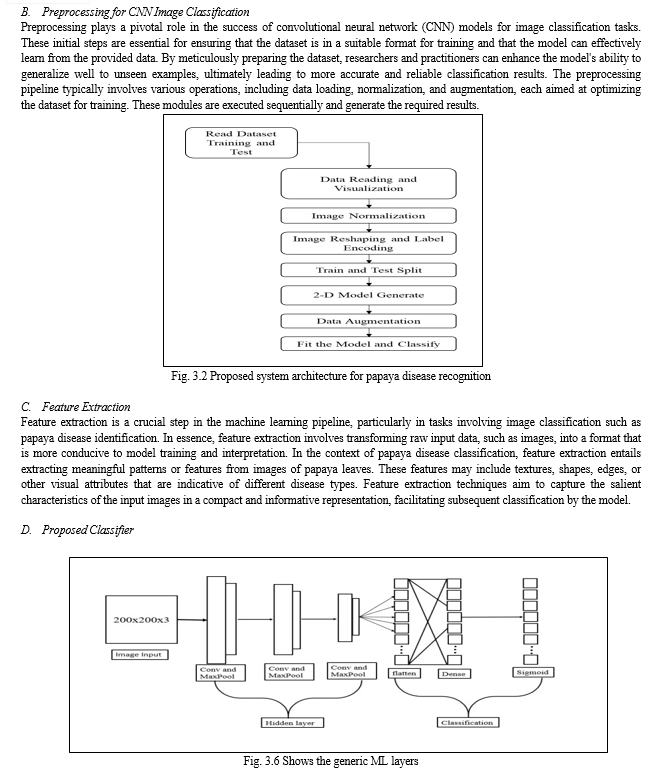
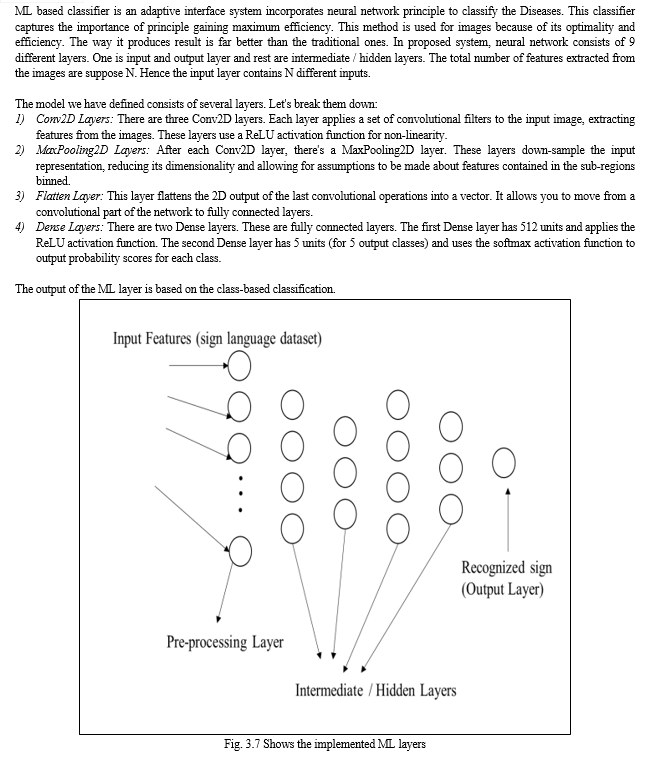
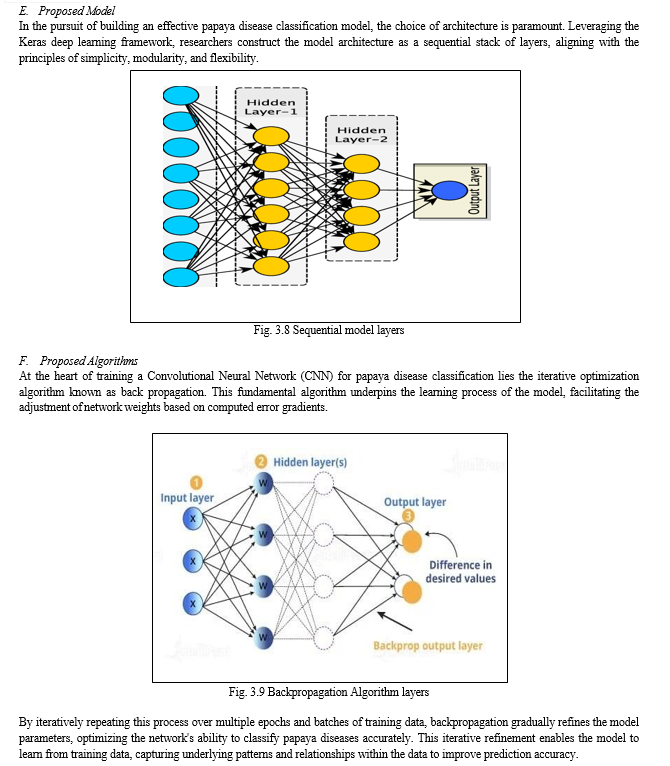
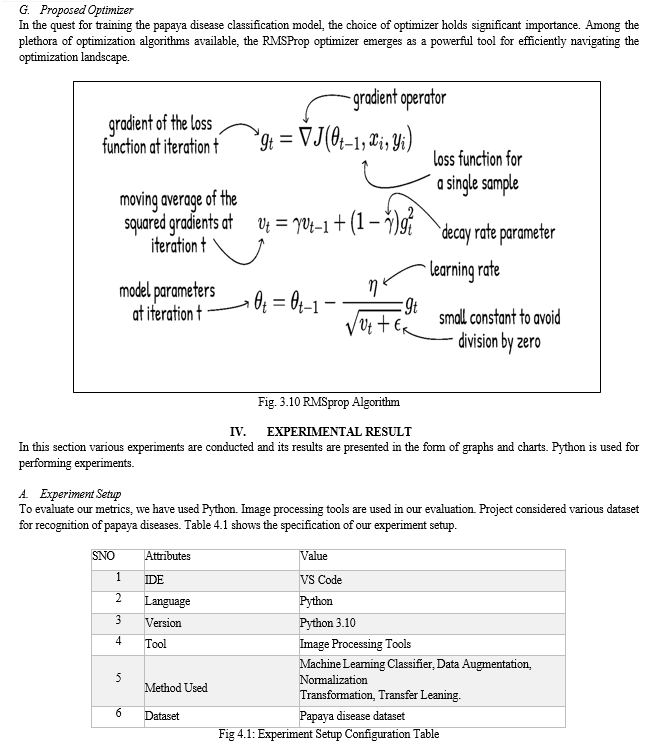
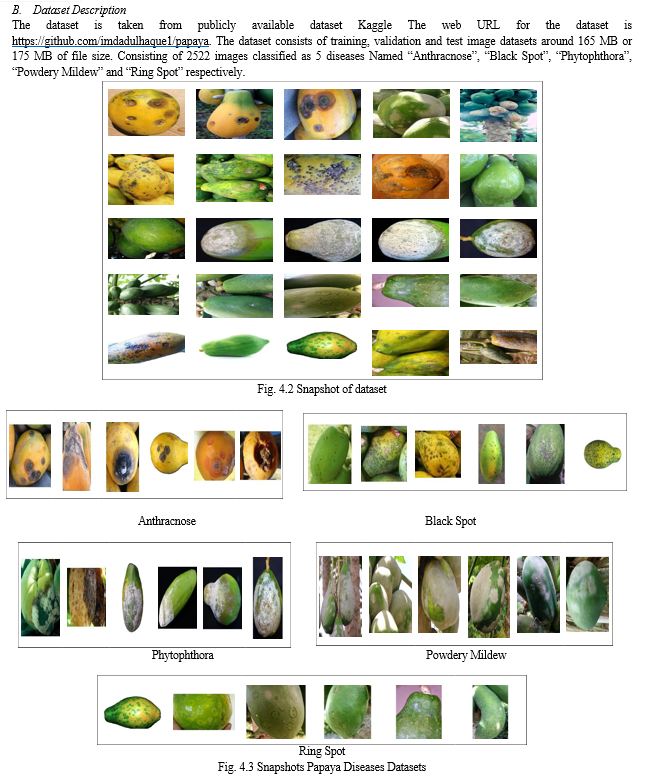

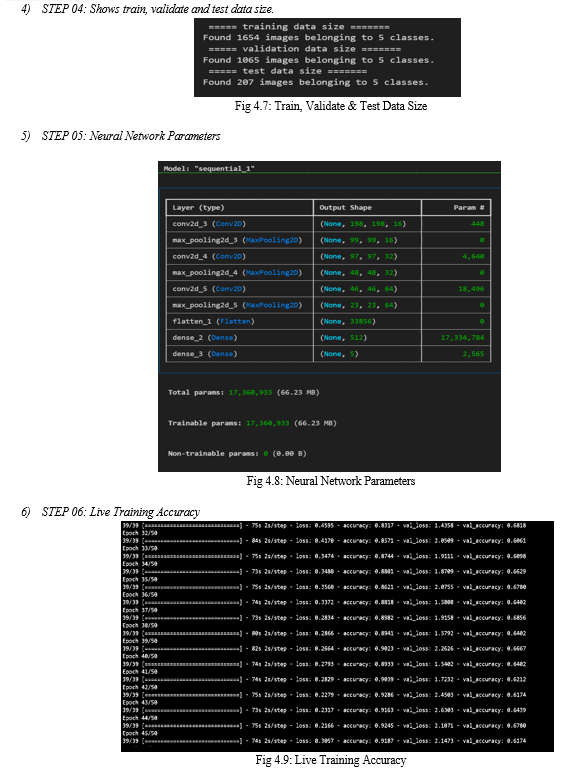
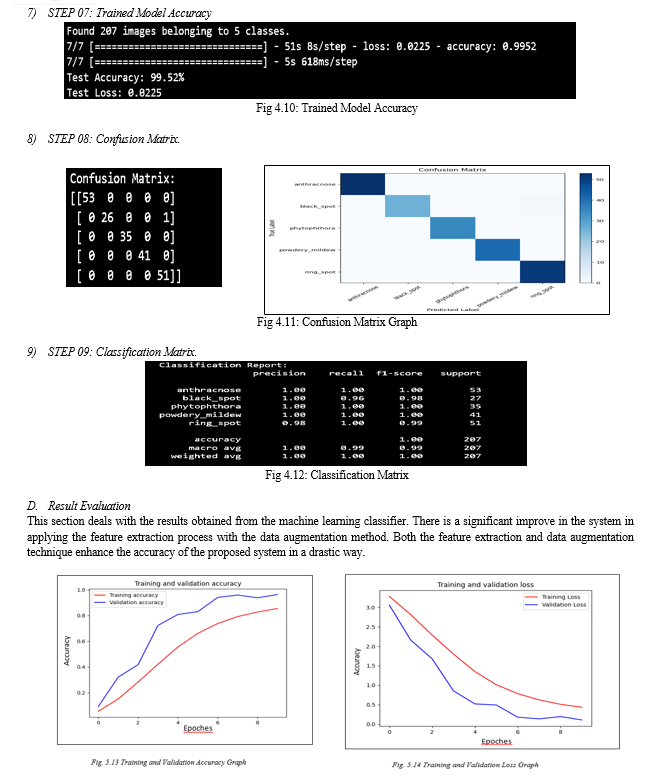
Conclusion
This proposed system recognizes Papaya disease Recognition. The strategy utilizes combination of various machine learning approaches. For improvement of older algorithm this thesis utilizes feature extraction with data augmentation technique. The proposed procedure is applied on poor quality papaya images of Kaggle and GitHub dataset, but still we obtained high accuracy in classification of those Diseases. The proposed system achieves ~94% accuracy in recognizing the Papaya diseases.In this project, we implemented many of the concepts. Currently We didn’t get the Best and correct dataset, So, in future if we get the correct and best dataset then, In future we would like to carry out the work with the correct and best dataset and increase our models accuracy and under fitting will be minimized.
References
[1] S. J. Banarase and S. D. Shirbahadurkar, “Papaya Diseases Detection Using GLCM Feature Extraction and Hyperparatuning of Machine Learning Approach BT - Proceedings of Third International Conference on Sustainable Expert Systems,” in Springer, 2023, pp. 145–158 [2] J. L. de Moraes, J. de Oliveira Neto, C. Badue, T. Oliveira-Santos, and A. F. de Souza, “Yolo-Papaya: A Papaya Fruit Disease Detector and Classifier Using CNNs and Convolutional Block Attention Modules,” Electronics (Switzerland), vol. 12, no. 10, 2023, doi: 10.3390/electronics12102202 [3] U. Premchand et al., “Survey, Detection, Characterization of Papaya Ringspot Virus from Southern India and Management of Papaya Ringspot Disease,” Pathogens, vol. 12, no. 6, p. 824, 2023, doi: 10.3390/pathogens12060824. [4] Md. Sagar Hossen, Md. Saif Islam, Md. Jannati Nime, Imdadul Haque, Md. Tanvir Ahmed, Md. Ashiqul Islam, Deep Learning Based Classification of Papaya Disease Recognition, Jan 2021 [5] Rashidul Hasan Hridoy, Mosammat Rokeya Anwar Tuli, A Deep Ensemble Approach for Recognition of Papaya Diseases using EfficientNet Models, November 21 [6] Jairo Lucas de Moraes * [ORCID] , Jorcy de Oliveira Neto, Claudine Badue, Thiago Oliveira- Santos and Alberto F. de Souza, Yolo-Papaya: A Papaya Fruit Disease Detector and Classifier Using CNNs and Convolutional Block Attention Modules, 12 May 202 [7] Veeraballi, R. K., Nagugari, M. S., Annavarapu, C. S. R., & Gownipuram, E. V. (2018, December). Deep Learning Based Approach for Classification and Detection of Papaya Leaf Diseases. In International Conference on Intelligent Systems Design and Applications (pp. 291- 302). Springer, Cham 6. Behera, S. K., Rath, A. K., & Sethy, P. K. (2020). [8] Kawaljit kaur, Chetan Marwaha, “Analysis of Diseases in Fruits using Image Processing Techniques”, International Conference on Trends in Electronics and Informatics ICEI 2017, 978- 1-5090-4257-9/17/$31.00 [9] Nikhitha M, Roopa Sri S, Uma Maheswari B, “Fruit Recognition and Grade of Disease Detection using Inception V3 Model”, Proceedings of the Third International Conference on Electronics Communication and Aerospace Technology [ICECA 2019] IEEE Conference Record # 45616; IEEE Xplore ISBN: 978-1-7281-0167-5. [10] J. A. Bacus and N. B. Linsangan, “Detection and Identification with Analysis of Carica papaya Leaf Using Android,” Journal of Advances in Information Technology, vol. 13, no. 2, pp. 162–166, 2022, doi: 10.12720/jait.13.2.162-166. [11] M. T. Habib, A. Majumder, A. Z. M. Jakaria, M. Akter, M. S. Uddin, and F. Ahmed, “Machine vision based papaya disease recognition,” Journal of King Saud University - Computer and Information Sciences, vol. 32, no. 3, pp. 300–309, 2020, doi: 10.1016/j.jksuci.2018.06.006. [12] S. K. Behera, A. K. Rath, and P. K. Sethy, “Maturity status classification of papaya fruits based on machine learning and transfer learning approach,” Information Processing in Agriculture, vol. 8, no. 2, pp. 244–250, 2021, doi: 10.1016/j.inpa.2020.05.003. [13] A. K. Azad, L. Amin, and N. M. Sidik, “Gene Technology for Papaya Ringspot Virus Disease Management,” The Scientific World Journal various, vol. 2014, 2014. [14] M. A. Islam, M. S. Islam, M. S. Hossen, M. U. Emon, M. S. Keya, and A. Habib, “Machine Learning based Image Classification of Papaya Disease Recognition,” Proceedings of the 4th International Conference on Electronics, Communication and Aerospace Technology, ICECA 2020, no. November, pp. 1353–1360, 2020, doi: 10.1109/ICECA49313.2020.9297570. [15] S. Yashodharan, “Neural Network for Papaya Leaf Disease Detection,” Acta Graphica, vol. 30, no. 3, pp. 11–24, 2019. [16] M. T. Habib, A. Majumder, A. Z. M. Jakaria, M. Akter, M. S. Uddin, and F. Ahmed, “Machine vision based papaya disease recognition,” Journal of King Saud University - Computer and Information Sciences, vol. 32, no. 3, pp. 300–309, 2020, doi: 10.1016/j.jksuci.2018.06.006. [17] W. E. Sari, Y. E. Kurniawati, and P. I. Santosa, “Papaya Disease Detection Using Fuzzy Naïve Bayes Classifier,” 2020 3rd International Seminar on Research of Information Technology and Intelligent Systems, ISRITI 2020, pp. 42–47, 2020, doi: 10.1109/ISRITI51436.2020.9315497. [18] R. H. Hridoy and M. R. A. Tuli, “A Deep Ensemble Approach for Recognition of Papaya Diseases using EfficientNet Models,” 2021 5th International Conference on Electrical Engineering and Information and Communication Technology, ICEEICT 2021, no. November, pp. 1–7, 2021, doi: 10.1109/ICEEICT53905.2021.9667825. [19] M. A. Islam, M. S. Islam, M. S. Hossen, M. U. Emon, M. S. Keya, and A. Habib, “Machine Learning based Image Classification of Papaya Disease Recognition,” Proceedings of the 4th International Conference on Electronics, Communication and Aerospace Technology, ICECA 2020, pp. 1353–1360, 2020, doi: 10.1109/ICECA49313.2020.9297570. [20] M. T. Habib, A. Majumder, A. Z. M. Jakaria, M. Akter, M. S. Uddin, and F. Ahmed, “Machine vision based papaya disease recognition,” Journal of King Saud University - Computer and Information Sciences, vol. 32, no. 3, pp. 300–309, 2020, doi: 10.1016/j.jksuci.2018.06.006 [21] M. S. Hossen, I. Haque, M. S. Islam, M. T. Ahmed, M. J. Nime, and M. A. Islam, “Deep learning based classification of papaya disease recognition,” Proceedings of the 3rd International Conference on Intelligent Sustainable Systems, ICISS 2020, pp. 945–951, 2020, doi: 10.1109/ICISS49785.2020.9316106. [22] Papaya Disease Dataset 1: https://universe.roboflow.com/sidd-b/disease- b/browse?queryText=&pageSize=50&startingIndex=0&browseQuery=true [23] Papaya Disease Dataset 2: https://github.com/imdadulhaque1/papaya [24] Papaya Fruit Diseases Detection (Binary Classification) using ML Techniquesby Jhaji Bhaskar: https://github.com/Jhajibhaskar/Papaya-Fruit-Disease-Detection-using-ML- Techniques?tab=readme-ov-file [25] Papaya-Fruit-Disease-Detection By Abhishek Kirtey: https://github.com/abhishektirkey/Papaya- Fruit-Disease-Detection [26] React JS Library: https://react.dev/ [27] Tailwind CSS Framework Guide: https://tailwindcss.com/docs/installation/framework-guides [28] ViteJS Build Tool Guide: https://vitejs.dev/guide/ [29] Machine Learning Guidance Using Krish Naik’s Playlist: https://www.youtube.com/channel/UCNU_lfiiWBdtULKOw6X0Dig
Copyright
Copyright © 2024 Preeti Gupta, Mr. Omprakash Sinha. This is an open access article distributed under the Creative Commons Attribution License, which permits unrestricted use, distribution, and reproduction in any medium, provided the original work is properly cited.

Download Paper
Paper Id : IJRASET63409
Publish Date : 2024-06-21
ISSN : 2321-9653
Publisher Name : IJRASET
DOI Link : Click Here
 Submit Paper Online
Submit Paper Online

